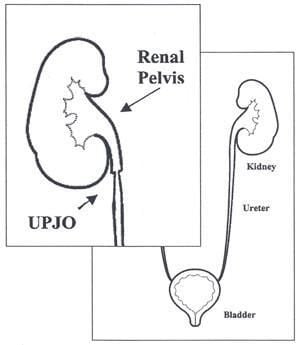Ureteropelvic Junction Obstruction (UPJO)
What is ureteropelvic junction obstruction?

An ureteropelvic junction obstruction (UPJO) is a blockage in the area where the ureter and the renal pelvis meet. The ureter is a tube that drains urine from the kidney to the bladder. The renal pelvis is the collecting area of the kidney. A blockage at this place can lead to urine backing up and enlarging the kidney (hydronephrosis).
How common is ureteropelvic junction obstruction?
UPJO is one of the most common birth defects of the ureter. It is more common in males and effects the left kidney more than the right. A blockage in both kidneys occurs in about 10 to 15% of the cases.
What causes ureteropelvic junction obstruction?
This defect occurs while the kidney is developing in the unborn infant. The cause of UPJO is not well understood. The result is a narrow segment of the ureter that causes a blockage. It is often found on prenatal ultrasounds.
Signs and Symptoms
UPJO may cause flank or back pain, blood in the urine, and repeated urinary tract infections. But most often there are no symptoms.
How is ureteropelvic junction obstruction diagnosed?
Special tests are done to look for UPJO. A renal ultrasound can help find out if there is enlargement of the kidney. A renal scan is needed to confirm blockage and assess how well the kidney is working. It is done by putting a dye into a vein and taking pictures as it travels into the kidney and down the ureter to the bladder.
How is ureteropelvic junction obstruction treated?
If the UPJO is severe, an operation called a pyeloplasty is performed. The blockage is removed, and the ureter is reattached to the kidney. This is done in the operating room under general anesthesia. A stent may be placed in the ureter, in some cases, to help drain the kidney. The stent will remain in place for about six weeks. Risks linked with a pyeloplasty include return of the blockage and infection, but the success rate is greater than 95 percent.
Print PageContact us to request an appointment or ask a question. We're here for you.



